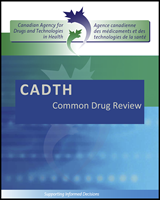Except where otherwise noted, this work is distributed under the terms of a Creative Commons Attribution-NonCommercial-NoDerivatives 4.0 International licence (CC BY-NC-ND), a copy of which is available at http://creativecommons.org/licenses/by-nc-nd/4.0/
NCBI Bookshelf. A service of the National Library of Medicine, National Institutes of Health.
Omalizumab (Xolair): Treatment of Adults and Adolescents (12 Years of Age and above) with Chronic Idiopathic Urticaria [Internet]. Ottawa (ON): Canadian Agency for Drugs and Technologies in Health; 2015 Aug.

Omalizumab (Xolair): Treatment of Adults and Adolescents (12 Years of Age and above) with Chronic Idiopathic Urticaria [Internet].
Show detailsAs stated in the CDR Clinical Review Report, the 150 mg dose of omalizumab failed to provide a clinically significant response in terms of UAS7 score at weeks 12 and 24. Therefore, CDR reanalysis did not consider scenario 2 and focused on the 300 mg dose of omalizumab from scenarios 1 and 3. Scenario 1 was identified to be the most representative of current Canadian clinical practice, where omalizumab will be used as a third- or fourth-line drug in the treatment of CIU, as mentioned in the Clinical Review Report. Scenario 3 is in line with requested listing criteria, where omalizumab would be used as a second-line drug.
- Shortening of the time horizon to 10 years:
- In scenario 1, the ICUR increased to $65,495 per QALY.
- In scenario 3, the ICUR increased to $100,639 per QALY.
- Treatment response (UAS7 ≥ 6) upon relapse (UAS7 ≤ 16) based on initial response probabilities:
- In scenario 1, the ICUR increased to $78,854 per QALY.
- In scenario 3, the ICUR increased to $95,434 per QALY.
- Higher spontaneous remission rates (Toubi et al. [2004]8):
- In scenario 1, the ICUR increased to $67,083 per QALY.
- In scenario 3, the ICUR increased to $102,737 per QALY.
- Re-treatment of patients in the mild urticaria health state:
- In scenario 1, the ICUR increased to $94,686 per QALY.
- In scenario 3, the ICUR increased to $127,576 per QALY.
- Equating the costs of LTRAs to $0.00 (scenario 1 only):
- The ICUR increased to $52,986 per QALY.
- Higher proportion of females to males for the all-cause mortality values:
- In scenario 1, the ICUR increased to $52,474 per QALY.
- In scenario 3, the ICUR increased to $81,130 per QALY.
For more detailed CDR reanalyses, see Table 13 in Appendix 5.
5.1. CADTH Common Drug Review Multi-Way Analysis
Upon conducting a multi-way analysis considering the limitations identified above, and assuming the manufacturer’s proposed 70% and30% patient split between severe and moderate patients respectively, in scenario 1, the ICUR for omalizumab 300 mg plus SOC versus SOC alone was $120,009 per QALY. Upon stratifying by severity (assuming 100% of patients are severe and 100% are moderate) considering these limitations, the ICUR ranges from $88,480 per QALY for the severe health state to $419,033 per QALY for the moderate health state.
In scenario 3, the ICUR for omalizumab 300 mg plus SOC versus SOC alone was $137,192 per QALY.
Upon stratifying by severity, the ICUR was $79,192 per QALY for the severe health state; for the moderate health state, omalizumab 300 mg plus SOC was dominated by SOC.
- CADTH COMMON DRUG REVIEW ANALYSES - Omalizumab (Xolair)CADTH COMMON DRUG REVIEW ANALYSES - Omalizumab (Xolair)
- SUMMARY OF MANUFACTURER’S SENSITIVITY ANALYSES - Omalizumab (Xolair)SUMMARY OF MANUFACTURER’S SENSITIVITY ANALYSES - Omalizumab (Xolair)
- Pharmacoeconomic Review Report - Ingenol Mebutate (Picato)Pharmacoeconomic Review Report - Ingenol Mebutate (Picato)
- Picryl ChloridePicryl ChlorideA hapten that generates suppressor cells capable of down-regulating the efferent phase of trinitrophenol-specific contact hypersensitivity. (Arthritis Rheum 1991 Feb;34(2):180...<br/>Year introduced: 1965MeSH
Your browsing activity is empty.
Activity recording is turned off.
See more...